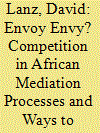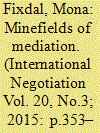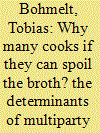|
|
|
Sort Order |
|
|
|
Items / Page
|
|
|
|
|
|
|
| Srl | Item |
| 1 |
ID:
160367


|
|
|
|
|
| Summary/Abstract |
Contemporary international mediation is often multiparty and involves a number of states and multilateral organisations. What are the conditions that account for successful multiparty mediation in conflict resolution? To address this question, I use qualitative comparative analysis (fsQCA) and focus on individual dimensions of mediation, namely internal cohesion of the mediating coalition, the use of reward and coercive power, and the presence of a ‘mutually hurting stalemate’ (MHS). I posit that the presence of a cohesive mediating coalition is a necessary condition for conflict resolution, whereas the provision of security guarantees, the imposition of sanctions and the presence of an MHS play a causal role in conflict resolution only in conjunction with other conditions. I test these conditions using a fuzzy-set approach and data from 20 mediated agreements over separatist conflicts in the post-cold war era. Empirical findings provide support for some of these propositions and challenge relevant theories of international mediation. More specifically, this research shows that a high convergence of interests among mediators is the only necessary – albeit not sufficient condition – for conflict resolution. Second, the analysis highlights the presence of two main sufficient paths for mediation success.
|
|
|
|
|
|
|
|
|
|
|
|
|
|
|
|
| 2 |
ID:
114695


|
|
|
|
|
| Publication |
2012.
|
| Summary/Abstract |
Crucial challenges for multiparty mediation processes include the achievement of adequate cooperation among the mediators and consequent coordination of their activities in the mediation process. Existing literature goes only as far as to make it clear that successful mediation requires necessary cooperation and coordination between mediators, as if these features were exogenous to the process. Available research does not consider whether these features might change over time and if such change could have an impact on the overall mediation process. Experience shows that it is not rare for mediators who were initially willing to pool their resources and act in concert with one another to decide at a later point to stop cooperating. Using a game theoretical model and a comparative analysis of three recent cases of multiparty mediation, this research illustrates the importance of maintaining necessary levels of cooperation and coordination to achieve successful outcomes and provides insights on how to achieve them in case the mediating coalition is faced with internal conflict of interests.
|
|
|
|
|
|
|
|
|
|
|
|
|
|
|
|
| 3 |
ID:
180894


|
|
|
|
|
| Summary/Abstract |
This article seeks to make sense of the dynamics of competition in African mediation processes and to outline approaches for effective cooperation between mediators. To this end, it analyzes four cases of recent peace processes: Sudan (1994–2005), Kenya (2008), Madagascar (2009–2013) and South Sudan (2013–2015). The article identifies four driving forces of competition among mediators: clashing interests of states involved in mediation, overlapping mediation mandates, incompatible norms guiding conflict resolution, and mediators’ lack of performance. These factors risk undermining peace processes unless the involved mediators and guarantors take active steps to mitigate the negative effects of competition. This can be done through ‘hierarchical coordination,’ where a recognized authority takes the lead and allocates roles to other actors, or through ‘collaborative cooperation,’ where partners have unity of purpose and decide on a division of labor based on comparative strengths.
|
|
|
|
|
|
|
|
|
|
|
|
|
|
|
|
| 4 |
ID:
141711


|
|
|
|
|
| Summary/Abstract |
This special issue explores significant problems of peace mediation. How do these “minefields of mediation” arise, how do mediators’ ways of handling them impact the negotiation process, and what can mediators do to overcome them? Using examples from the last quarter century, and from the Middle East in particular, the authors examine these questions at different stages of the mediation process, from its initiation to its culmination, and with reference to different forms of mediation, including facilitation, muscular, and multiparty mediation. This short introduction provides a systematic overview of some of the most pertinent mediation challenges, with reference to whothe mediators are, whenthe mediation takes place and whatthe issues of contention and possible outcomes are. These areas are of course all intertwined, and, as the articles in this issue point out, are also very much influenced by changes in the domestic, regional and international environment.
|
|
|
|
|
|
|
|
|
|
|
|
|
|
|
|
| 5 |
ID:
141712


|
|
|
|
|
| Summary/Abstract |
Multiparty mediation, which occurs when two or more third parties cooperate or compete in helping antagonists negotiate a conflict settlement, carries both risks and rewards as a conflict management strategy. Cooperating multiple third parties can increase the chances of crafting an agreement, band together to create greater pressure on the conflict parties to reach agreement, and supply outside resources to help implement the negotiated agreement. Competing multiple third parties can undercut each other, prolonging the conflict and allowing antagonists to resist necessary compromises and negotiated concessions. This article examines the changing environment for multiparty mediation and the impact of five changes that affect the practice of mediation. It derives some interim conclusions about where the field is heading and offers some recommendations for making multiparty engagements more effective.
|
|
|
|
|
|
|
|
|
|
|
|
|
|
|
|
| 6 |
ID:
117595


|
|
|
|
|
| Publication |
2012.
|
| Summary/Abstract |
Which factors drive the onset of multiparty mediation? Despite numerous studies explaining the onset of international mediation in conflicts, the literature offers little insight into when we are likely to see 'multiparty mediation', that is, mediation attempts that are conducted by a coalition of interveners. The latter are different from those interventions that only see one mediator, however: mediators forming a coalition are likely to be constrained by different domestic factors and may have different incentives than states pursuing unilateral approaches. Thus, ignoring these patterns can have serious consequences for our theoretical expectations and empirical inferences on mediation onset. In order to address this shortcoming, this article introduces concepts from the coalition-formation literature to the existent research on mediation, and examines the onset of multiparty mediation from a twofold perspective. First, there are supply-side determinants, that is, interveners' incentives for multiparty mediation. Second, the author studies demand-side influences, that is, factors pertaining to the belligerents. By analyzing data for 1950-2000, the following research's main contribution stems from the empirical test of the theoretical framework in a quantitative research design. The results point to a disconnect between the factors that promote single-party mediation onset and those that promote multiparty mediations.
|
|
|
|
|
|
|
|
|
|
|
|
|
|
|
|
|
|
|
|
|